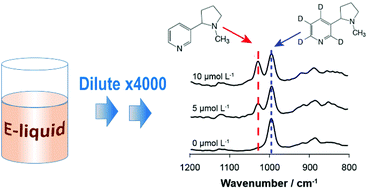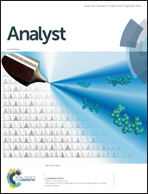High dilution surface-enhanced Raman spectroscopy for rapid determination of nicotine in e-liquids for electronic cigarettes†
Abstract
The rise in popularity of electronic cigarettes and the associated new legislation concerning e-liquids has created a requirement for a rapid method for determining the nicotine content of e-liquids in the field, ideally at the point of sale. Here we have developed a rapid method based on surface-enhanced Raman spectroscopy (SERS) with Au colloids and an isotope-labeled nicotine (d4-nicotine) internal standard for the measurement/quantification of samples which contain 10s of mg mL−1 nicotine in a complex viscous matrix. This method is novel within the area of SERS because it uses high dilution (ca. 4000×) in the sample preparation which dilutes out the effects of the viscous glycerin/glycerol medium and any flavouring or colouring agents present but still allows for very accurate calibration with high reproducibility. This is possible because the nicotine concentration in the e-liquids (≤24 mg mL−1) is of several orders of magnitude above the working range of the SERS measurement. This method has been tested using a portable Raman spectrometer and a very large set of 42 commercial e-liquids to check that there is no matrix interference associated with different manufacturers/flavourings/colouring agents etc. Finally, as an alternative to determining the nicotine concentration by measuring peak heights in the spectra, the concentration was also estimated by comparing the sample spectra with those of a set of standard samples which were prepared at known concentrations and held in a spectral library file in the spectrometer. This simple approach allows the concentration to be estimated without any complex data analysis and lends itself readily to a handheld Raman system which is typically designed to carry out library searching using the internal software for materials identification. Library searching against standards correctly classified 41 of the 42 test liquids as belonging to the correct concentration group. This high dilution SERS approach is suitable for the analysis of sample types that have reasonably high concentrations of analytes but suffer from matrix problems, and it therefore has broad potential for applications across food, pharmaceutical and nutraceutical areas.



 Please wait while we load your content...
Please wait while we load your content...